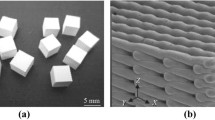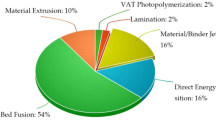Abstract
This study draws attention to the issue of how sensitive a low-cost 3D printer is to the material deposition sequence, when trying to speed up the process by applying tool-path optimization. The objective was to evaluate the influence of some changes in the deposition sequence on the mechanical properties, dimensional variation, and building time of specimens manufactured in polylactic acid (PLA). To achieve that, three deposition strategies were planned considering different deposition sequences, with and without optimization. An experiment involving an interruption of the extrusion nozzle was also designed to analyze the influence of idle time during material deposition. The material properties were evaluated by tensile and three-point bending tests. The results showed that a longer idle time between adjacent raster segments caused material cool-down, which, in this study, decreased the tensile strength by 35% and the flexural strength by 46%. Therefore, in a low-cost 3D printer, if the user does not pay attention to the deposition sequence during tool-path optimization, the mechanical property of the material can be badly affected. Additionally, the optimized intercalated deposition sequence allowed for savings of up to 42.7% in manufacturing time, and no expressive dimensional variation was found between the deposition strategies.
Similar content being viewed by others
References
ISO/ASTM 52900 (2015) Additive manufacturing—general principlesTerminology
Gibson I, Rosen DW, Stucker B (2010) Additive manufacturing technologies. Springer, New York
Volpato N, Galvão LC, Nunes LF, Scanavini LG (2015) Combining heuristics for tool-path optimization in additive manufacturing, computer-aided production engineering - 23rd CAPE conference. University of Edinburgh, Edinburgh
Agarwala MK, Jamalabad VR, Langrana NA, Safari A, Whalen PJ, Danforth SC (1996) Structural quality of parts processed by fused deposition. Rapid Prototyping J 2:4–19
Han W, Jafari MA, Seyed K (2003) Process speeding up via deposition planning in fused deposition-based layered manufacturing processes. Rapid Prototyping J 9(4):212–218
Castelino K, D'Souza R, Wright PK (1999) Toolpath optimization for minimizing airtime during machining. J Manuf Syst 22(3):173–180
Jin Y-a, He Y, Xue G-h, Fu J-z (2015) A parallel-based path generation method for fused deposition modeling. Int J Adv Manuf Technol 77:927–937
Wah PK, Murty KG, Joneja A, Chiu LC (2002) Tool path optimization in layered manufacturing. IEEE Transactions 34:335–347
Weidong Y (2009) Optimal path planning in rapid prototyping based on genetic algorithm, Chinese Control and Decision Conference (CCDC 2009), pp. 5068–5072
Dreifus G, Goodrick K, Giles S, Patel M, Foster RM, Williams C, Lindahl J, Post B, Roschli A, Love L, Kunc V (2017) Path optimization along lattices in additive manufacturing using the Chinese postman problem. 3D. Print Addit Manuf 4(2):98–104
Lensgraf S, Mettu RR (2016) Beyond layers: a 3d-aware toolpath algorithm for fused filament fabrication, IEEE International Conference on Robotics and Automation, May 2, pp. 3625–3631
Faes M, Ferraris E, Moens D (2016) Influence of inter-layer cooling time on the quase-static properties of ABS components produced via fused deposition modeling”, 18th CIRP conference on electro physical and chemical machining, April, Tokyo
Sun Q, Rizvi GM, Gu P, Bellehumeur CT (2008) Effect of processing conditions on the bounding quality of FMD polymer filaments. Rapid Prototyping J 14:72–80
Huang B (2014) Alternate slicing and deposition strategies for Fused Deposition Modelling, Ph.D. Thesis, Auckland University of Technology, School of Engineering, January, 336p
Gurrala PK, Regalla SP (2014) Part strength evolution with bonding between filaments in fused deposition modelling. Virtual and Physical Prototyping 9:141–149
ATSM D638-14 (2014) Standard test methods for tensile properties of plastics, American society for testing and materials (ASTM) international
ATSM D790-10 (2010) Standard test methods for flexural properties unreinforced and reinforced plastics and electrical insulating materials, American society for testing and materials (ASTM) International
Funding
This work was supported by the Coordenação de Aperfeiçoamento de Pessoal de Nível Superior (CAPES, Brazil) and Fundação Araucária do Paraná (Brazil).
Author information
Authors and Affiliations
Corresponding author
Ethics declarations
Conflict of interest
The authors declare that they have no conflict of interest.
Rights and permissions
About this article
Cite this article
Volpato, N., Zanotto, T.T. Analysis of deposition sequence in tool-path optimization for low-cost material extrusion additive manufacturing. Int J Adv Manuf Technol 101, 1855–1863 (2019). https://doi.org/10.1007/s00170-018-3108-1
Received:
Accepted:
Published:
Issue Date:
DOI: https://doi.org/10.1007/s00170-018-3108-1




